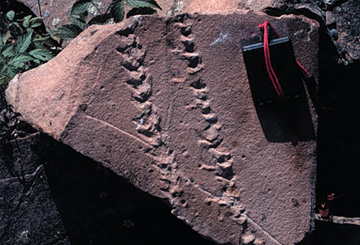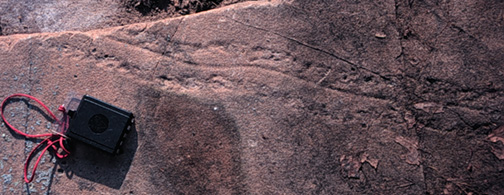Geotimes

Web Extra
Wednesday, May 8
First steps on land
In an inactive quarry in southeastern Ontario, a series of tracks line the
surfaces of fossil dunes. These scurry marks, laid down as long as 500 million
years, may be the oldest known footprints on land. Their makers may have been
amphibious creatures and could mark the transition from marine- to land-dwelling
species.
Robert MacNaughton of the Geological Survey of Canada and colleagues report
in this month's Geology that a type of arthropod took a jaunt over some
sand that was either dry or damp at the time. The tracks that were left behind
vary from deeply set appendage marks, sometimes with central drag grooves, to
lighter imprints that could have been made in dry sand.
 The rocks themselves
show marks of eolian, or wind-deposited, beds. MacNaughton says that past researchers
believed that storms washed the animals who made the tracks into the inter-dune
areas and then submerged them underwater.
The rocks themselves
show marks of eolian, or wind-deposited, beds. MacNaughton says that past researchers
believed that storms washed the animals who made the tracks into the inter-dune
areas and then submerged them underwater.
"In all the time that we spent looking," MacNaughton says, "we
never found any evidence that this was the case." Ephemeral streams may
have traversed the dune field, but the researchers found no evidence of standing
water in the layers with the tracks. Overlying deposits from a shallow marine
environment indicate the region may have been a transitional marine environment,
contributing to the hypothesis that these arthropods were amphibious.
Field photographs of representative
arthropod trackways in Cambrian-Ordovician sandstone near Kingston, Ontario.
The above image shows a robust trackway with well-developed appendage marks
and no central drag. Note push-ups of sand associated with appendage impressions.
Photos courtesy of R. MacNaughton.
MacNaughton's team report that the tracks themselves show that the creatures
were similar to a large centipede, some of which had a spiny tail like a horseshoe
crab's. At least eight pairs of legs carried one of these large arthropods,
with tracks as wide as 13 centimeters. The individuals walked with an "in-phase
gait," a trait associated with swimming and other underwater movement.
Because the tracks vary in size, several individuals probably made them, and
the authors hypothesize that they were foraging for food or preying on other
smaller amphibians. Another possible pastime could have been mating, just as
horseshoe crabs come ashore to lay their eggs and return to the sea. 
This photo called taildrag, shows a
trackway with central drag and poorly defined appendage marks. Top surface.
Surface dips to top of photograph.
If these sandstone rocks are correctly dated, the timing of this fieldtrip
pushes back the earliest footprints of a creature on land by about 40 million
years, to the Late Cambrian. Fossil deposits in younger rocks give the youngest
possible age of the deposits of being Early Ordovician, but the oldest possible
age is not well constrained. The tracks occur in sandstone deposits related
to a formation that begins in New York. Traveling north is like taking a ride
forward through time. Because the tracks are in the southern region of the deposits
and low enough in the formation, the researchers think they are likely from
the Late Cambrian.
"It would be nice to see these types of fossils in deposits with better
time controls," says James Whitey Hagadorn, a paleontologist at CalTech
in Pasadena, Calif. "We need to look into earlier eolian and marine environments
for evidence of animal life." This "fantastic discovery," Hagadorn
says, invites paleontologists to revisit the assumption that there's no life
on land in the Cambrian -- a geologic time period where it may be worthwhile
to look for further evidence of terrestrial incursions.
Naomi Lubick
Geotimes contributing writer
 The rocks themselves
show marks of eolian, or wind-deposited, beds. MacNaughton says that past researchers
believed that storms washed the animals who made the tracks into the inter-dune
areas and then submerged them underwater.
The rocks themselves
show marks of eolian, or wind-deposited, beds. MacNaughton says that past researchers
believed that storms washed the animals who made the tracks into the inter-dune
areas and then submerged them underwater.

